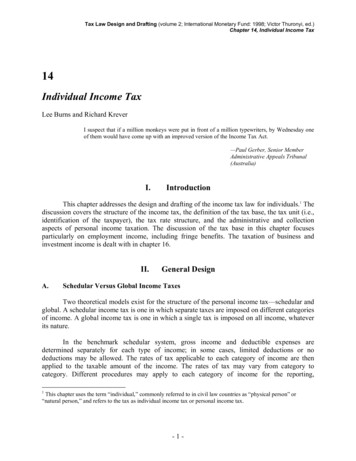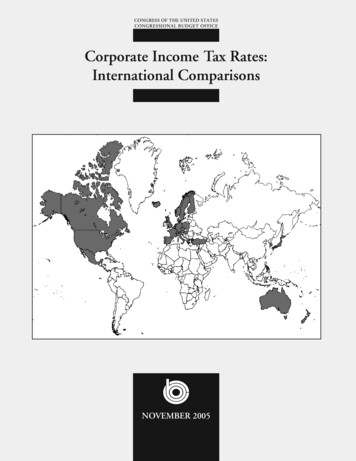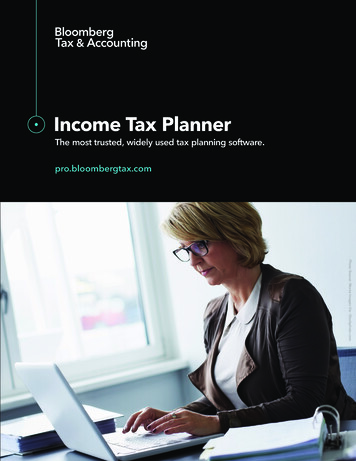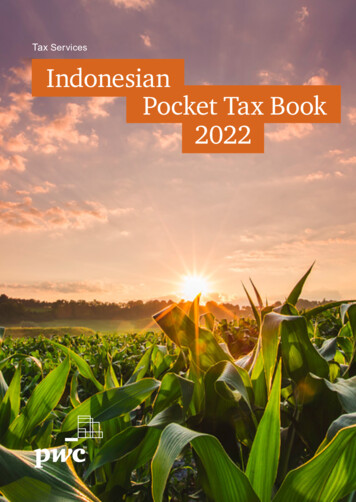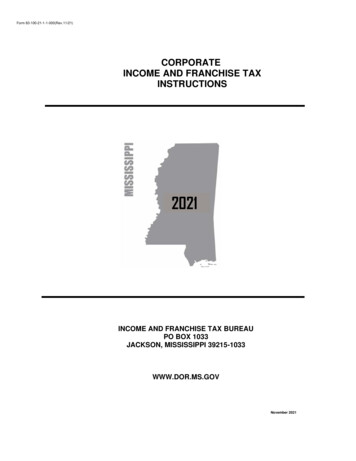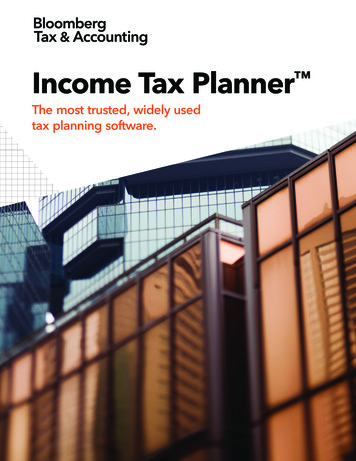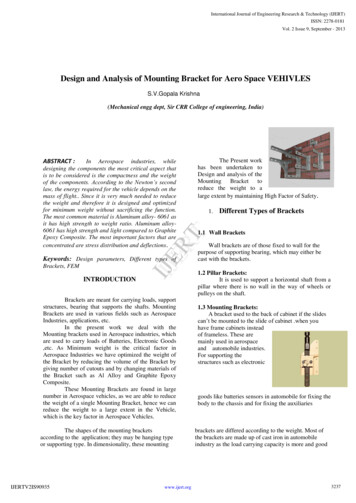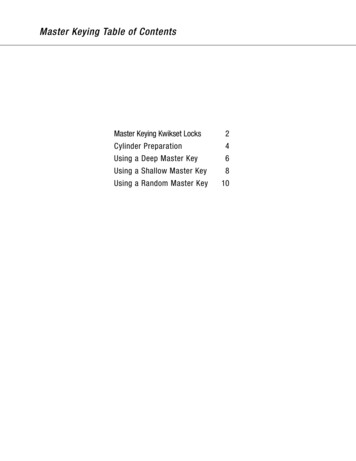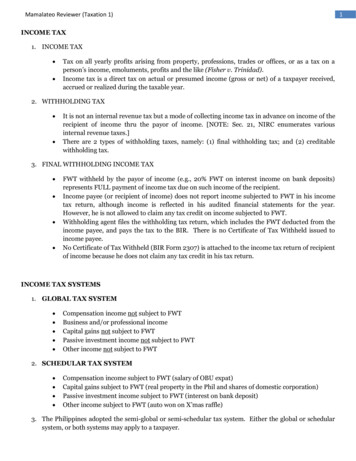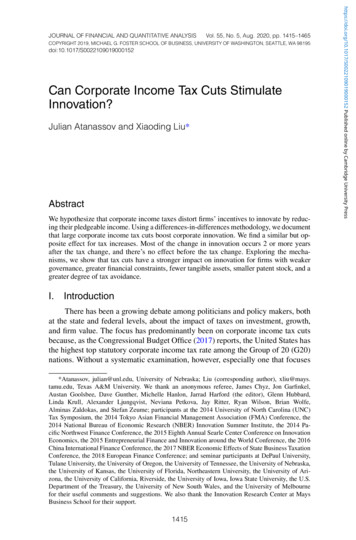
Transcription
Vol. 55, No. 5, Aug. 2020, pp. 1415–1465COPYRIGHT 2019, MICHAEL G. FOSTER SCHOOL OF BUSINESS, UNIVERSITY OF WASHINGTON, SEATTLE, WA 98195doi:10.1017/S0022109019000152Can Corporate Income Tax Cuts StimulateInnovation?Julian Atanassov and Xiaoding Liu*AbstractWe hypothesize that corporate income taxes distort firms’ incentives to innovate by reducing their pledgeable income. Using a differences-in-differences methodology, we documentthat large corporate income tax cuts boost corporate innovation. We find a similar but opposite effect for tax increases. Most of the change in innovation occurs 2 or more yearsafter the tax change, and there’s no effect before the tax change. Exploring the mechanisms, we show that tax cuts have a stronger impact on innovation for firms with weakergovernance, greater financial constraints, fewer tangible assets, smaller patent stock, and agreater degree of tax avoidance.I.IntroductionThere has been a growing debate among politicians and policy makers, bothat the state and federal levels, about the impact of taxes on investment, growth,and firm value. The focus has predominantly been on corporate income tax cutsbecause, as the Congressional Budget Office (2017) reports, the United States hasthe highest top statutory corporate income tax rate among the Group of 20 (G20)nations. Without a systematic examination, however, especially one that focuses*Atanassov, julian@unl.edu, University of Nebraska; Liu (corresponding author), xliu@mays.tamu.edu, Texas A&M University. We thank an anonymous referee, James Chyz, Jon Garfinkel,Austan Goolsbee, Dave Gunther, Michelle Hanlon, Jarrad Harford (the editor), Glenn Hubbard,Linda Krull, Alexander Ljungqvist, Neviana Petkova, Jay Ritter, Ryan Wilson, Brian Wolfe,Alminas Zaldokas, and Stefan Zeume; participants at the 2014 University of North Carolina (UNC)Tax Symposium, the 2014 Tokyo Asian Financial Management Association (FMA) Conference, the2014 National Bureau of Economic Research (NBER) Innovation Summer Institute, the 2014 Pacific Northwest Finance Conference, the 2015 Eighth Annual Searle Center Conference on InnovationEconomics, the 2015 Entrepreneurial Finance and Innovation around the World Conference, the 2016China International Finance Conference, the 2017 NBER Economic Effects of State Business TaxationConference, the 2018 European Finance Conference; and seminar participants at DePaul University,Tulane University, the University of Oregon, the University of Tennessee, the University of Nebraska,the University of Kansas, the University of Florida, Northeastern University, the University of Arizona, the University of California, Riverside, the University of Iowa, Iowa State University, the U.S.Department of the Treasury, the University of New South Wales, and the University of Melbournefor their useful comments and suggestions. We also thank the Innovation Research Center at MaysBusiness School for their 152 Published online by Cambridge University PressJOURNAL OF FINANCIAL AND QUANTITATIVE ANALYSIS
Journal of Financial and Quantitative Analysison the long term, it is difficult to evaluate the importance of corporate incometaxes.In this article, we examine the impact of corporate income tax cuts on corporate innovation. Hall, Jaffe, and Trajtenberg (2005) and Kogan, Papanikolaou,Seru, and Stoffman (2017) demonstrate that innovation significantly increasesfirm value and growth.1 More broadly, the seminal work by Solow (1957) andRomer (1990) shows that innovation is the most important driver of long-termeconomic growth. Recent research in economics and finance has studied the impact of corporate income taxes on firm investment and business activity (Cummins, Hassett, and Hubbard (1996), Giroud and Rauh (2019)). Less is known,however, about how tax cuts can affect long-term firm output and performance. Bylooking at innovation, we fill the gap in the literature by tracing a possible channel through which corporate income taxes can influence firm value and long-termgrowth. We theoretically argue and empirically document that corporate incometax cuts significantly affect innovation by changing firms’ pledgeable income andimproving their incentives to innovate. We also provide motivation and evidencefor several unexplored mechanisms through which that relationship occurs.To overcome identification challenges, we use staggered changes in state corporate income tax rates that are largely exogenous to the decision of the individualfirm to innovate. We eliminate the impact of time-varying economy-wide shocks(e.g., changes in monetary policy and federal regulation) by comparing the changein innovation in a treatment group of firms that experienced a tax change to a control group of firms that did not experience a change over the same time period. Wealso eliminate omitted-variable biases that could result from cross-country studiesdue to large differences in unobservable country-specific characteristics. State taxchanges are staggered over time, which can put the same firm in both the treatmentand control groups over our time period, allowing us to control for unobservablefirm characteristics.There are two opposing theoretical views about the relationship between corporate income tax cuts and innovation. The first view contends that corporateincome taxes distort the incentives of firms to innovate. In Appendix A, we develop a simple model that analyzes the impact of corporate income taxes on firmbehavior in the presence of agency problems. We use Tirole’s (2006) notion ofpledgeable income to demonstrate that in the presence of private benefits of control and differential effort, higher taxes make it more lucrative for managers andother employees to shirk by enjoying the quiet life or undertaking routine projectsrather than working hard and innovating. Consequently, projects that would notbe undertaken when taxes are high will become profitable and will be undertakenif taxes are reduced because they become incentive compatible. The results fromthe model also imply that increases in after-tax profits do not have to finance theentire innovative project to motivate the firm to undertake it. Even small changesin tax rates can lead to large changes in innovation if, on the margin, they provide1Kogan et al. (2017) document that a 1-standard-deviation increase in an aggregate innovationindex is associated with a 1.6%–6.5% increase in economic output and a 0.6%–3.5% increase in totalfactor productivity over a horizon of 5 years. They also find that firms with a 1-standard-deviationincrease in their innovation output experience higher growth of 2.5%–4.6% over a period of 5 years.https://doi.org/10.1017/S0022109019000152 Published online by Cambridge University Press1416
1417enough incentives for managers to exert time and effort and switch from undertaking routine projects to innovative projects.We show that pledgeable income depends on firms’ after-tax profits as well ason the size of the private benefits of control and the assets at hand, such as internalfunds, physical assets, patent stock, and other tangible and intangible assets thatcan be used in the innovative project. We then derive several predictions from themodel that allow us to trace some of the mechanisms through which corporateincome tax cuts affect innovation. We demonstrate that the impact of tax cuts isgreater for firms with weaker governance, for financially constrained firms, andfor firms with fewer tangible assets and a smaller patent stock.In addition to increasing pledgeable income, there are at least two other reasons why corporate income tax cuts might stimulate innovation. First, innovativefirms often save their after-tax profits and use the internal cash as a cushion duringdifficult times. Internal cash, combined with imperfect external capital markets,allows greater flexibility and tolerance of experimentation, which, according toManso (2011), is key to motivating innovation. Because innovation is a highlyuncertain process, firms with more cash savings will be better suited to weatherunfavorable outcomes and continue to innovate. Second, innovative firms oftenprefer to use after-tax internal funds for innovative projects (Brown, Fazzari, andPetersen (2009)) rather than tap external markets. In addition, Brown, Martinsson,and Petersen (2012) document that financial constraints are an important deterrent to research and development (R&D). Therefore, we hypothesize that ceterisparibus, tax cuts will relieve financial constraints, increase firms’ internal funds,and lead to higher innovation.The alternative view argues that corporate income tax cuts either do not matter or have a negative impact on innovation, for the following reasons: First, anypossible tax decrease may result in an increase in the state budget deficit or in adecrease in state government spending on public goods, such as research, education, and infrastructure. As a result, there would be fewer positive spillover effectson firms, which will in turn inhibit their innovative output. This is the criticismthat has been levied on the 2012 Kansas tax cuts and on the 2017 tax cuts enacted at the federal level by the Trump administration. Second, changes in statetaxes, even large ones, could have only a small effect on firms and not significantly change their innovation policies. Finally, assuming all R&D expendituresare tax deductible, perfect capital markets, and no private benefits of control orasymmetric information, tax rates would not matter, and any project with a positive net present value (NPV) will be financed no matter how high tax rates are. Ifa project is profitable (has a positive NPV) on a pretax basis, it will be profitableon an after-tax basis because both revenues and expenses are multiplied by the taxrate. The tax rate will only determine how the economic pie is divided; it will notaffect its size.The two views just presented generate opposing testable predictions. To ensure consistency and relevance, we examine the impact of tax cuts on innovationusing significant decreases of at least 100 basis points (bps) (e.g., from 7% to6%) in the top-bracket state corporate income tax rate from 1988 to 2006. We usestatutory rather than effective tax rates because the former is outside of the controlhttps://doi.org/10.1017/S0022109019000152 Published online by Cambridge University PressAtanassov and Liu
Journal of Financial and Quantitative Analysisof the individual firm, whereas the latter is endogenous.2 Although prior studiestypically use company headquarters to define states, in many cases a firm’s corporate office is not where its major operations are located. To better identify the mostrelevant state to which the tax rate is applied, we use the most mentioned state ina firm’s 10-K reports based on data from Garcia and Norli (2012). We follow theexisting literature (e.g., Hall, Jaffe, and Trajtenberg (2001)) and use patents andcitations per patent to measure the quantity and quality of innovation.We find that tax cuts significantly increase the number of patents and citations per patent. The effect on citations per patent is stronger, suggesting that thequality of innovation is affected even more by changes in taxes. Firms operatingin a state that implements a tax cut create 0.63 and 0.79 more patents 3 and 4years later, respectively, relative to otherwise similar firms that do not have a taxcut. These are increases of approximately 1.2% and 1.4% of 1 standard deviation.In terms of innovation quality, firms receive 0.75 more citations per patent 3 and 4years after a major tax decrease, which are increases of approximately 5.4% of 1standard deviation. We also find that tax increases have a negative and significanteffect on innovation, although the economic magnitude is smaller. The symmetriceffect that we document is consistent with our main hypothesis and with Giroudand Rauh (2019), who find that both large state tax increases and decreases havea significant effect on the number of establishments and employees.This finding is novel and substantially different from a recent article byMukherjee, Singh, and Zaldokas (2017) that also studies the impact of corporate income taxes on innovation but fails to find an effect for tax cuts. Tax cutsare the main focus of our article and a topic of contentious contemporary policydebate. In contrast to our article, Mukherjee et al. (2017) suggest that governmentpolicies to cut corporate income taxes at the state level and, if we extrapolate, atthe federal level will not matter. In addition, unlike Mukherjee et al. (2017), wealso examine several previously unexplored mechanisms to better understand whytax cuts are an important driver of corporate innovation. Finally, as we explain inour discussion section, their methodology and variable definition of tax decreasesdo not allow for a proper evaluation of the long-term effects of tax cuts.Having illuminated our understanding of whether tax cuts affect innovation,our next step is to explore the specific channels through which this relationshipmay occur. Understanding the mechanisms is important for two reasons. First,it improves our understanding of how taxes work and provides better insight forfuture research and policy making. Second, it also reduces the concern that therelation between taxes and innovation is spurious and driven by other changesthat may have occurred at the same time. Such a criticism will have the burden ofexplaining not only the main relation but also all the channels that we document.After exploring the channels in separate regressions and also together in the sameregression, we find that corporate governance, financial constraints, collateral, andtax-avoidance channels capture distinct aspects of the relation between corporateincome taxes and innovation.2As we show in Section V.C, the statutory rates are strongly positively related to the actual stateincome taxes firms pay.https://doi.org/10.1017/S0022109019000152 Published online by Cambridge University Press1418
1419We first test the argument that tax cuts increase firms’ pledgeable income byreducing the incentives of managers to shirk or engage in routine projects. If that isthe case, firms with weaker governance (where the incentives to shirk are greater)will benefit more from tax cuts. To test this hypothesis derived from our model, weuse the hostile takeover index developed by Cain, McKeon, and Solomon (2017).Consistent with our hypothesis, we find that the effect of tax cuts on innovation issignificantly larger for firms with weaker corporate governance.Next, we argue that tax cuts increase firms’ pledgeable income by increasingthe availability of financial resources and relieving financial constraints. To testthis hypothesis, we use several measures of financial constraints based on Whitedand Wu (2006), Kaplan and Zingales (1997), and Hadlock and Pierce (2010). Wefind that the positive impact of tax decreases on the number of citations per patentis greater for financially constrained firms. We also find that smaller firms andfirms with smaller free-cash cushions are affected more by tax changes.Consistent with the assets-at-hand hypothesis, we also provide evidence thatfirms with fewer tangible assets are affected more by tax cuts. Tangible assetsare easier to liquidate, and therefore firms with fewer tangible assets have lowerpledgeable income. We also argue that although firms mainly use tangible assetsas collateral, intangible assets such as the current patent stock can also be usedas collateral by innovative firms (Hochberg, Serrano, and Ziedonis (2015)). Motivated by this idea, we further examine a firm’s existing patent stock and findevidence that firms with a lower patent stock benefit more from tax cuts.Taxes may also affect innovation by distorting firm behavior and resourceallocation and encouraging firms to engage in tax-shifting activities. There aretwo opposing predictions. On the one hand, firms that avoid taxes would be lessaffected by tax cuts because they have already shifted their tax burden. On theother hand, both tax avoidance and innovation require scarce resources, such asmanagerial and employee creativity and effort.3 When the return on tax avoidanceincreases relative to the return on innovation, firms will shift more resources totax avoidance. We examine the tax-avoidance hypothesis using an indicator of taxavoidance based on industry- and size-adjusted cash effective tax rates (Dyreng,Hanlon, and Maydew (2008)). The results support the second prediction. We findthat the impact of tax cuts on the number of citations per patent is greater forfirms that engage more in tax avoidance. This finding is again consistent with ourgeneral hypothesis that tax cuts improve the allocation of resources and firms’incentives to innovate.We further investigate whether state corporate income taxes affect the observable inputs to innovation. We find a significant positive impact of tax decreases on R&D expenditures starting 1 year after the tax change. Similarly, thereis a significant negative impact of tax increases on R&D expenditures, indicating asymmetric effect. We also find significant effects for executive incentive compensation, after-tax cash flow, and external finance, suggesting that major corporateincome tax cuts have a significant impact on the inputs to innovation that are subsequently used to generate higher innovative output.3For example, top managers of Apple and Google have spent numerous hours responding to legislators about their tax practices instead of focusing on innovative 52 Published online by Cambridge University PressAtanassov and Liu
Journal of Financial and Quantitative AnalysisBy employing tax changes that are largely outside of the control of the individual firm and a differences-in-differences (DID) methodology, we address manyof the potential endogeneity concerns in our main analysis. We also control fornumerous observable time-variant factors, time fixed effects, and unobservabletime-invariant characteristics, such as corporate culture and risk aversion, by using firm fixed effects. Moreover, we pursue several strategies that further mitigateresidual biases that could stem from reverse causality or omitted variables. First,we conduct a dynamic analysis and demonstrate that most of the impact of taxcuts on innovation occurs 2 or more years after the tax cuts are implemented. Second, we restrict tax cuts to those that are unanticipated and also use a narrativeapproach to identify exogenous tax cuts that are passed independently of localeconomic conditions. Third, we control for additional fixed effects and state-levelvariables such as other tax-related policies. Fourth, we conduct a falsification testand find that tax cuts have the opposite effect on firms in neighboring states. Together, this evidence further reduces the possibility that our results are driven byomitted variables or alternative policy changes.The article contributes to several strands of literature. First, we build on andcomplement the previous literature that examines the relation between taxes andfirm investment and financing decisions (Cummins et al. (1996), Hassett and Hubbard (2002), Djankov, Ganser, McLiesh, Ramalho, and Shleifer (2010), Heiderand Ljungqvist (2015), and Giroud and Rauh (2019)). Different from the extantresearch, we show that private benefits of control and differential effort are essential for understanding the impact of taxes on the incentives to innovate. Wefocus on innovative output rather than input and, unlike Mukherjee et al. (2017),demonstrate that both corporate income tax decreases and increases have a significant impact on the quantity and quality of innovation. We also propose anddocument several mechanisms through which taxes affect innovation. In addition,to the best of our knowledge, this is the first tax article to use a novel measure,different from firm headquarters, to better identify the relevant state for corporateincome tax purposes.Second, we contribute to the literature on financial constraints and R&D.A number of studies (e.g., Himmelberg and Petersen (1994), Bhagat and Welch(1995), and Hall and Lerner (2010)) find mixed evidence on how financing frictions affect R&D in the United States and other countries. Using changes instate corporate income taxes as an exogenous shock to financial constraints andexamining innovation outputs, we lend additional support to studies (e.g., Hall(1992), Brown et al. (2009), (2012)) showing that financial constraints reduceR&D and innovation. More broadly, we also contribute to the literature examiningthe impact of financial constraints on firm behavior, which is a central question inboth corporate finance (e.g., Kaplan and Zingales (1997)) and asset pricing (e.g.,Whited and Wu (2006)).Finally, current academic research has extensively debated the role of taxes inpromoting economic growth (e.g., Romer and Romer (2010), Barro and Redlick(2011), and Ramey (2011)). However, the existing evidence is conflicting, andseveral unresolved issues still remain. First, most of the prior research has lookedat short-term economic growth. Less is known about how taxes affect long-termeconomic growth. Second, there is little evidence on the specific channels throughhttps://doi.org/10.1017/S0022109019000152 Published online by Cambridge University Press1420
1421which taxes affect growth. Third, it is often difficult to control for simultaneityand omitted-variable biases in a macroeconomic setting. We contribute to thisimportant debate by focusing on corporate innovation as a source of long-termeconomic growth and use staggered changes in state corporate income tax ratesfor identification. In doing so, we provide indirect evidence of a possible channelthrough which corporate income taxes can affect economic growth.The rest of the article is organized as follows: Section II describes thedata and the empirical methodology. Section III presents the main empirical results. Section IV investigates the channels through which taxes affect innovation.Section V provides additional endogeneity and robustness tests. Section VI compares our methodology and results to related research. Section VII concludes. InAppendix A, we present a simple theoretical model that formalizes some of theintuitive arguments presented in the Introduction that motivate the relationshipbetween corporate income taxes and innovation.II.Data and Variable ConstructionWe acquire state corporate income tax information from the University ofMichigan’s World Tax Database, The Book of the States, and the Tax Foundation.Garcia and Norli (2012) provide the number of times a state is mentioned in afirm’s 10-K reports, which we use to determine the most relevant state to which thetax rate is applied. The historical states of incorporation and location come fromthe Compact Disclosure database and the parsed 10-K data from Bill McDonald’sWeb site (https://sraf.nd.edu).The sample is constructed by selecting all U.S. publicly traded firms fromthe National Bureau of Economic Research (NBER) patent file4 that have financial data available in the Standard & Poor’s (S&P) Compustat database. We alsoinclude all firms from Compustat that operate in the same 4-digit Standard Industrial Classification (SIC) industries as the firms in the patent database but do nothave patents. Including these firms alleviates sample-selection concerns becausethe sampling procedure is independent of whether the firm has patents or not. Adrawback of this approach may be that for some firms or industries, patentingmight not be an accurate measure of innovation, or some industries might not beinnovative at all. To address these concerns, we also conduct our analysis only oninnovative companies or industries and find similar and generally stronger results.We start our sample in 1988 due to the availability of Compact Disclosure,which is used to construct an alternative measure of the most relevant state. Onlyfirms that are incorporated and headquartered in the United States are included.Firms in the financial (SIC 6), utilities (SIC 49), and public (SIC 9) sectorsare excluded. The final sample includes 87,564 firm-years based on 8,013 firmsover the period of 1988–2006.4For a detailed description of the patent data set, see Hall et al. (2001).https://doi.org/10.1017/S0022109019000152 Published online by Cambridge University PressAtanassov and Liu
A.Journal of Financial and Quantitative AnalysisMain Explanatory Variables: Major Decreases and Increases in StateCorporate Income Tax RatesTo examine the impact of corporate income taxes on innovation, we needto properly define the tax signals that would most likely affect firm incentives.There are two issues to consider here. First, innovation is a long-term activity thatrequires a significant amount of both tangible and intangible firm resources. Thus,it is unlikely that firms will react to small tax changes, especially those that areexpected to be reversed. Firms are more likely to respond to large tax changesthat may signal a change in tax policy that lasts for an extended period of time.Second, as Griliches (1990) argues, the innovation lag is poorly defined because itmay take years from the change in incentives to the creation of patents. Therefore,looking at numerous small tax changes that could be reversed within 1 or 2 yearswill introduce noise into our estimates. Our measure of tax changes largely avoidthese two problems.Specifically, in order to identify more permanent tax signals that are likelyto have a long-lasting impact on corporate innovation, we focus on major statecorporate income tax changes that are not reversed in 3 years. The key explanatoryvariable in our analysis is an indicator, TAXDECRst , which takes a value of 1 ifat time t in state s there has been a major decrease in the state corporate incometax rate, and 0 otherwise.5 A major change in tax rates is defined as a change ofgreater than or equal to 100 bps (e.g., from 7% to 6%) that is enacted in 1 or 2consecutive years, as long as that change is not reverted within the next 3 years.A major tax decrease is reverted if the tax rate is raised to a level at or abovethe level prior to the tax decrease, and a major tax increase is reverted if the taxrate is lowered to a level at or below the level prior to the tax increase. If a taxchange is reverted within the next 3 years, it is not considered a change, and thetax variable retains a value of 0. If the change is reverted more than 3 years later,the tax variable takes a value of 1 in the year of the change and any year afterwhen the change is present, and it switches back to 0 if the change is reverted.6In addition, we create another variable, TAXINCRst , that is equal to 1 if attime t in state s there has been a major (as previously defined) increase in thestate corporate income tax rate, and 0 otherwise. We conduct analysis with thatvariable and find results consistent with our hypothesis and with previous findingsin the literature, but we focus our investigation predominantly on tax cuts. We alsocreate a combined categorical tax variable, TAXCHGst , which equals 1 if at timet in state s there has been a major increase in state corporate income tax rates, 1if at time t in state s there has been a major decrease in state corporate income taxrates, and 0 otherwise. In our sample, the average major tax decrease is 150 bps,and the average major tax increase is also 150 bps, which is 22% of the average topmarginal state tax rate of 6.9%. In other words, a major tax decrease or increaserepresents a 22% change in the tax rate on average.5We choose to use indicator variables to implement a DID methodology and for the dynamicanalysis described next. For robustness, we use the actual change in the tax rate (i.e., from 1% to3.75%) or the percentage change in the tax rate instead of a dummy and find similar results.6For example, New Hampshire experienced a major tax decrease in 1994, and the tax rate returnedto the level prior to the change in 1999. In this case, the tax decrease indicator equals 1 for the years1994–1998, and 0 for all other years.https://doi.org/10.1017/S0022109019000152 Published online by Cambridge University Press1422
1423To identify the major tax changes, we use state tax rate data from the University of Michigan’s World Tax Database, The Book of the States, and the TaxFoundation. The World Tax Database provides state corporate tax rates from 1941to 2002, and the Tax Foundation provides state corporate tax rates from 2000 to2013. We check these data with the state corporate income tax rates reported inThe Book of the States to ensure consistency and accuracy. For states with multipletax brackets, we focus on changes in the top tax bracket while accounting for taxsurcharges. The major tax increases and decreases are identified in Table 1. From1988 to 2006, 10 states experienced a major tax increase, and 8 states experienceda major tax decrease.7We also verify our major tax changes with the lists of tax changes fromHeider and Ljungqvist (2015) and Giroud and Rauh (2019).8 There are a fewsmall differences between the 3 sets of tax changes, which we verify using otherdata sources, and we perform robustness checks to make sure the differences donot affect our results. In Heider and Ljungqvist’s (2015) article, there are 90 taxchanges during our sample period. Of the 90 tax changes, 33 are changes of 25 bpsor smaller, 12 are changes of greater than 25 bps and less than 50 bps, and 21 arereversals within 3 years. Although 27 of the 90 tax changes are changes that aregreater than or equal to 100 bps that are enacted in 1 or 2 consecutive years,6 are reverted within 3 years, and 3 additional ones are already included in theTABLE 1Significant Changes in State Corp
pact of corporate income taxes on firm investment and business activity (Cum-mins, Hassett, and Hubbard (1996), Giroud and Rauh (2019)). Less is known, however, about how tax cuts can affect long-term firm output and performance. By looking at innovation, we fill the gap in the literature by tracing a possible chan-


